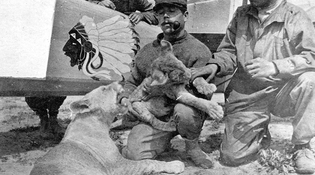 loading
loading
Old YaleYale’s World War I flying aceWilliam Thaw ’15 was one of the founding members of the famed Lafayette Escadrille. Judith Ann Schiff is chief research archivist at the Yale University Library.  National Museum of the US Air ForceWorld War I fighter pilot William Thaw, Class of 1915, with the two lions—Whiskey and Soda—he bought as mascots for the Lafayette Escadrille. Behind Thaw is a plane decorated with the insignia of the Lafayette. It had been designed by another Yale member of the squadron, Edward Foote Hinkle ’99. View full image“I found myself all alone against four Germans with only one motor,” wrote pilot William Thaw, Class of 1915, in a 1915 letter to his brother from France, “but the Boches [Germans] had grown cautious by this time.… One, however, got up nerve enough to try to cut off my retreat, but… I was able to give him a couple of dozen bullets from our trusty gun (made in U.S.A.) and he fell en masse just behind the German lines.” Thaw was the first US pilot to volunteer for France in World War I and one of the original nine members of the Lafayette Escadrille, a famous squadron of US volunteer pilots flying for France. He was an expert pilot—the first to take a plane up New York City’s East River and fly underneath all four bridges. In the summer of 1914, Thaw, who had left Yale for a career as an aviator, was in Paris, along with his personal Curtiss Hydro flying boat. When the war started, he donated his plane to the French and enlisted in the French Foreign Legion. In December 1914, following basic training, Thaw qualified for service in a French escadrille (squadron). In April 1916, he joined the newly formed Escadrille Américaine—later called the Lafayette Escadrille, in honor of France’s role in the American Revolution. Thaw must have appreciated the name; he had enlisted on August 21, 1914, to commemorate Lafayette’s visit to Yale College on August 21, 1824. After America declared war in April 1917, the squadron would be transferred to the American Air Service. At least four other Yale alumni would serve in the squadron: Edward Foote Hinkle ’99, Ray Claffin Bridgman ’17, Julian Cornell Biddle ’12, and Dumarque Spencer ’17. The last two died in service and are remembered in Yale’s Memorial Hall. Thaw had a lighthearted side. On a trip to Paris in fall 1916, he bought a lion cub and named it “Whiskey.” For his journey back to the base, he got a ticket that would let him bring a dog onto the train. As a friend of Thaw’s told it, the conductor asked, “What is that animal?” and Thaw answered, “An African dog.” Then Whiskey roared and showed his claws, “women jumped out of the carriage in terror,” and Thaw and Whiskey were banished to the baggage car. But the Escadrille pilots welcomed Whiskey as their new mascot; with some training he “soon became the best behaved of lions.” Thaw later bought a mate for Whiskey that he named Soda. Thaw was perhaps the most celebrated pilot in the squadron. He is believed to have been the first American to take part in WWI aerial combat, winning his first air battle at Verdun in May 1916. Although a bullet broke his arm that year, he stayed in the service a long time: by the spring of 1918, he was the only one of the original nine members of the Lafayette still at the front. He also became one of the elite “flying aces”—pilots who had shot down at least five enemy aircraft. Many of his letters home were published in the Yale Daily News and the Yale Alumni Weekly, and accounts of his exploits appeared in the national press. Among his numerous decorations were a Croix de Guerre, the Légion d’Honneur, and a Distinguished Service Cross—which he received for leading a patrol of three planes that attacked eight enemy aircraft, downing three and dispersing the rest. By the end of the war he had been promoted to lieutenant colonel and made commander of the Lafayette. When Thaw died of pneumonia at 40, his New York Times obituary praised the Lafayette Escadrille for writing “blazing chapters in the history of wartime aviation.” Thaw himself, it said, had been known to the French as “the American Eagle.”
|
|
3 comments
-

John Claridge '49, 12:53pm January 14 2015 |  Flag as inappropriate
Flag as inappropriate
-

Darroch Greer, 1:35pm January 15 2015 |  Flag as inappropriate
Flag as inappropriate
-

Steve Tom, 8:34pm October 19 2015 |  Flag as inappropriate
Flag as inappropriate
The comment period has expired.On page 9 of Samuel Hynes' The Unsubstantial Air, American Fliers in the First World War; there is a group photo of the original seven American members of the Lafayette Escadrille but none are individually identified. Could you pick out William Thaw for me.
Hi John,
William Thaw is not in either of those photos, unless that's him with his head cut off in the photo above or he's standing behind Capt. Thenault holding the map in the photo from Mr. Hynes book. Thaw was a stocky man with a thick black mustache, and he looked older than most of the other young fliers.
Here's a good article on the Lafayette with two photos of Thaw:
http://www.airspacemag.com/military-aviation/americas-first-combat-pilots-180953371/?no-ist
Best, Darroch
You mentioned that many of Bill Thaw's letters home had been published in the Yale Daily News and the Yale Alumni Weekly. Is there any way I could get a copy of those letters? Do you know what happened to the rest of Thaw's war letters? I am researching the early history of the Lafayette Escadrille and while I have found collections of several pilots' letters in museums and college libraries I have not been able to find any reference to Bill Thaw's letters.
Thank you in advance for any help you may be able to provide.
Steve Tom